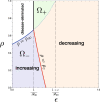What Influence Could the Acceptance of Visitors Cause on the Epidemic Dynamics of a Reinfectious Disease?: A Mathematical Model
- PMID: 38402514
- PMCID: PMC10894808
- DOI: 10.1007/s10441-024-09478-w
What Influence Could the Acceptance of Visitors Cause on the Epidemic Dynamics of a Reinfectious Disease?: A Mathematical Model
Abstract
The globalization in business and tourism becomes crucial more and more for the economical sustainability of local communities. In the presence of an epidemic outbreak, there must be such a decision on the policy by the host community as whether to accept visitors or not, the number of acceptable visitors, or the condition for acceptable visitors. Making use of an SIRI type of mathematical model, we consider the influence of visitors on the spread of a reinfectious disease in a community, especially assuming that a certain proportion of accepted visitors are immune. The reinfectivity of disease here means that the immunity gained by either vaccination or recovery is imperfect. With the mathematical results obtained by our analysis on the model for such an epidemic dynamics of resident and visitor populations, we find that the acceptance of visitors could have a significant influence on the disease's endemicity in the community, either suppressive or supportive.
Keywords: Epidemic dynamics; Mathematical model; Ordinary differential equations; Public health; Reinfection.
© 2024. The Author(s).
Conflict of interest statement
The authors state that there are no conflicts in interest.
Figures














Similar articles
-
SIRI+Q model with a limited capacity of isolation.Theory Biosci. 2025 Jun;144(2):121-144. doi: 10.1007/s12064-025-00437-8. Epub 2025 Mar 29. Theory Biosci. 2025. PMID: 40158025 Free PMC article.
-
A model for epidemic dynamics in a community with visitor subpopulation.J Theor Biol. 2019 Oct 7;478:115-127. doi: 10.1016/j.jtbi.2019.06.020. Epub 2019 Jun 20. J Theor Biol. 2019. PMID: 31228488 Free PMC article.
-
Epidemic dynamics with a time-varying susceptibility due to repeated infections.J Biol Dyn. 2019 Dec;13(1):567-585. doi: 10.1080/17513758.2019.1643043. J Biol Dyn. 2019. PMID: 31370752
-
Forecasting the future of HIV epidemics: the impact of antiretroviral therapies & imperfect vaccines.AIDS Rev. 2003 Apr-Jun;5(2):113-25. AIDS Rev. 2003. PMID: 12876900 Review.
-
Ebola outbreak in West Africa, 2014 - 2016: Epidemic timeline, differential diagnoses, determining factors, and lessons for future response.J Infect Public Health. 2020 Jul;13(7):956-962. doi: 10.1016/j.jiph.2020.03.014. Epub 2020 May 29. J Infect Public Health. 2020. PMID: 32475805 Review.
References
MeSH terms
LinkOut - more resources
Full Text Sources

